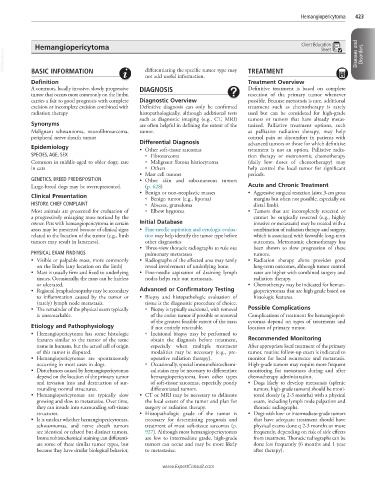Page 875 - Cote clinical veterinary advisor dogs and cats 4th
P. 875
Hemangiopericytoma 423
Hemangiopericytoma Client Education
Sheet
VetBooks.ir Diseases and Disorders
differentiating the specific tumor type may
BASIC INFORMATION
not add useful information. TREATMENT
Definition Treatment Overview
A common, locally invasive, slowly progressive DIAGNOSIS Definitive treatment is based on complete
tumor that occurs most commonly on the limbs; resection of the primary tumor whenever
carries a fair to good prognosis with complete Diagnostic Overview possible. Because metastasis is rare, additional
excision or incomplete excision combined with Definitive diagnosis can only be confirmed treatment such as chemotherapy is rarely
radiation therapy histopathologically, although additional tests used but can be considered for high-grade
such as diagnostic imaging (e.g., CT, MRI) tumors or tumors that have already metas-
Synonyms are often helpful in defining the extent of the tasized. Palliative treatment options, such
Malignant schwannoma, neurofibrosarcoma, tumor. as palliative radiation therapy, may help
peripheral nerve sheath tumor control pain or discomfort in patients with
Differential Diagnosis advanced tumors or those for which definitive
Epidemiology • Other soft-tissue sarcomas treatment is not an option. Palliative radia-
SPECIES, AGE, SEX ○ Fibrosarcoma tion therapy or metronomic chemotherapy
Common in middle-aged to older dogs; rare ○ Malignant fibrous histiocytoma (daily low doses of chemotherapy) may
in cats ○ Others help control the local tumor for significant
• Mast cell tumors periods.
GENETICS, BREED PREDISPOSITION • Other skin and subcutaneous tumors
Large-breed dogs may be overrepresented. (p. 628) Acute and Chronic Treatment
• Benign or non-neoplastic masses • Aggressive surgical resection (aim: 3-cm gross
Clinical Presentation ○ Benign tumor (e.g., lipoma) margins but often not possible, especially on
HISTORY, CHIEF COMPLAINT ○ Abscess, granuloma distal limb).
Most animals are presented for evaluation of ○ Elbow hygroma • Tumors that are incompletely resected or
a progressively enlarging mass noticed by the cannot be surgically resected (e.g., highly
owner. Pets with hemangiopericytoma in certain Initial Database invasive or metastatic) may be treated with a
areas may be presented because of clinical signs • Fine-needle aspiration and cytologic evalua- combination of radiation therapy and surgery,
related to the location of the tumor (e.g., limb tion may help identify the tumor type before which is associated with favorable long-term
tumors may result in lameness). other diagnostics outcomes. Metronomic chemotherapy has
• Three-view thoracic radiographs to rule out been shown to slow progression of these
PHYSICAL EXAM FINDINGS pulmonary metastases tumors.
• Visible or palpable mass, more commonly • Radiographs of the affected area may rarely • Radiation therapy alone provides good
on the limbs (any location on the limb) reveal involvement of underlying bone. long-term outcomes, although tumor control
• Mass is usually firm and fixed to underlying • Fine-needle aspiration of draining lymph rates are higher with combined surgery and
tissues. Occasionally, the mass can be hairless nodes helps rule out metastasis. radiation therapy.
or ulcerated. • Chemotherapy may be indicated for heman-
• Regional lymphadenopathy may be secondary Advanced or Confirmatory Testing giopericytomas that are high grade based on
to inflammation caused by the tumor or • Biopsy and histopathologic evaluation of histologic features.
(rarely) lymph node metastasis. tissue is the diagnostic procedure of choice.
• The remainder of the physical exam typically ○ Biopsy is typically excisional, with removal Possible Complications
is unremarkable. of the entire tumor if possible or removal Complications of treatment for hemangioperi-
of the greatest feasible extent of the mass cytomas depend on types of treatments and
Etiology and Pathophysiology if not entirely resectable. location of primary tumor.
• Hemangiopericytoma has some histologic ○ Incisional biopsy may be performed to
features similar to the tumor of the same obtain the diagnosis before treatment, Recommended Monitoring
name in humans, but the actual cell of origin especially when multiple treatment After appropriate local treatment of the primary
of this tumor is disputed. modalities may be necessary (e.g., pre- tumor, routine follow-up exam is indicated to
• Hemangiopericytomas are spontaneously operative radiation therapy). monitor for local recurrence and metastasis.
occurring in most cases in dogs. ○ Occasionally, special immunohistochemi- High-grade tumors may require more frequent
• Disturbances caused by hemangiopericytomas cal stains may be necessary to differentiate monitoring for metastases during and after
depend on the location of the primary tumor hemangiopericytoma from other types chemotherapy administration.
and invasion into and destruction of sur- of soft-tissue sarcomas, especially poorly • Dogs likely to develop metastasis (splenic
rounding normal structures. differentiated tumors. tumors, high-grade tumors) should be moni-
• Hemangiopericytomas are typically slow • CT or MRI may be necessary to delineate tored closely (q 2-3 months) with a physical
growing and slow to metastasize. Over time, the local extent of the tumor and plan for exam, including lymph node palpation and
they can invade into surrounding soft-tissue surgery or radiation therapy. thoracic radiographs.
structures. • Histopathologic grade of the tumor is • Dogs with low- or intermediate-grade tumors
• It is unclear whether hemangiopericytomas, necessary for determining prognosis and that have adequate treatment should have
schwannomas, and nerve sheath tumors treatment of most soft-tissue sarcomas (p. physical exams done q 2-3 months or more
are identical or related but distinct tumors. 927). Although most hemangiopericytomas frequently, depending on risk of side effects
Immunohistochemical staining can differenti- are low to intermediate grade, high-grade from treatment. Thoracic radiographs can be
ate some of these similar tumor types, but tumors can occur and may be more likely done less frequently (6 months and 1 year
because they have similar biological behavior, to metastasize. after therapy).
www.ExpertConsult.com

